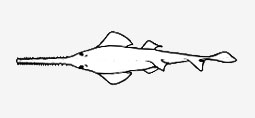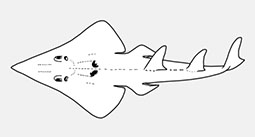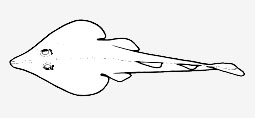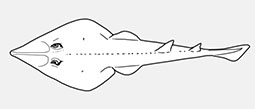
Glaucostegidae - (Giant guitarfishes)
Indo-Pacific and Eastern Atlantic, including Mediterranean Sea; tropical and subtropical inshore continental and insular seas; intertidal habitats and some species are recorded from fresh and brackish waters; Bottom-dwellers, often resting on soft mud or sandy bottoms; strong swimmers.
Species of this family are characterized by a flattened, spade-like to wedge-shaped disc and a robust, depressed hark-liketrunk; snout typically long and its tips varies from being acute or bluntly rounded, to protruding forward as a large, bulbous lobe; eyes typically small and widely separated, spiracles small with 1-2 variably developed folds; nostrils long and almost transverseto oblique with many lamellae (up to 94); no nasal curtain, anterior nasal flaps are relatively narrow and joined posteriorly to the inner edge of the nostril; mouth profile straight;;skin with fine denticles, with small thorns variably confied to a row along mid-line of body and small patches near eyes, on shoulder and sometimes on snout (often better developed in young than adults; long-based pelvic fins positioned laterally, posterior to the disc; 2 similarly-shaped, upright dorsal fins are well separated, the first positioned well behind the tips of the pelvic fins; small, posteriorly directed caudal fin without ventral lobe typical of wedgefishes (Rhinidae); colour plain browish or greyish dorsally with anterior cranium and rostral cartilage sharply demarcated from a much paler translucent snout; none of the species has spots, stripes nor blotches; underside usually white but the ventral snout appears weakly translucent nad it tip can hav ea black blotch.
Feed mainly on benthic invertebrates, including small benthic fishes.
Ovoviviparous.
Maximum size: most exceed 2 m TL and some reaching 3 m TL or more.
Distribution: Atlantic, Indian, and Pacific Oceans. Snout elongated into a long flat blade with teeth of uniform size deeply embedded on each side. No barbels. Head depressed. The body more or less resembling a shark. Two distinct dorsal fins. Giant fishes of coastal waters, entering estuaries and ascending large rivers for great distances. Ovoviviparous, embryos feed solely on yolk (Ref. 50449). Used for food and regarded as exciting game fishes because of their size. Although generally harmless to humans, their large size and sawlike beak make them dangerous when hooked or speared. Of the many nominal species only four appear to be valid.
Distribution: Indo-Pacific and Atlantic Ocean (1-2 spp). Primarily marine with one Rhina in freshwater. Mostly found in warm temperate to tropical inshore continental seas and rarely deeper than 400 m. Habitat: Strong swimmers and bottom-dwellers that rest rather than burrow on muddy or sandy bottoms. Diet: Feed on benthic invertebrates amd small bottom-dwelling fishes. Use: Sought after for their meat and highly valued large fins that has led to overfishing and population decline in some areas. Popular in public aquaria. Caught mainly as bycatch by trawls, gill and tangle nets and longlines. Morphology: Wedgefishes are shark-like rays, the size of which is medium to large (0.7-3.1 m TL as adults and weigh at least 227 kg). It has a variably depressed trunk, weakly formed disc, a head either thickened and broadly domed, or flattened wedge-shaped or rounded; pectoral fins are triangular and joined with the body behind eye level; long and narrow nostrils, usually lie oblique to a small horizontal mouth with rounded oval teeth that lack distinct cusps; anterior nasal flaps poorly developed and do not form a nasal curtain; spiracles large with 0-3 skin folds along the hind margin; robust tail slightly longer than the disc; upright dorsal fins 2, first above the pelvic fins; a well-developed bilobed caudal fin with strongly concave posterior margin; pelvic fins moderately sized, angular and not divided inlto 2 lobes; skin with minute denticles and there is a variably developed series of thorns alon ghte dorsal mid-line, and usually 2-3 short serires on each shoulder; dorsal surface mainly yellowish to greyish brown and white ventrally; often with rows of white spots and ocelli, and often with a black blotch on each pectoral fin (pectoral marking) that is variably surrounded by white spots (generally obvious in young); undersurface of the snout can have a blackish marking. Genera: Rhina, Rhynchobatus, Rhynchorhina.
Distribution: Atlantic, Indian and Pacific Oceans mostly in tropical coastal waters (rarely entering estuaries and freshwater). Adults attaining 1.7 m TL (Ref. 108568) Body form intermediate between that of a shark and a skate. Also called shovelnose sharks. Numerous small, blunt teeth in jaws. Two large dorsal fins; origin of first dorsal behind pelvics; caudal fin well developed. Denticles arranged in a row on dorsal midline. No spine in tail. They reach moderate to large size and are important commercial species in many coastal nations. Ovoviviparous, young born fully developed. Feed on bottom organisms, including molluscs and crustaceans, but will also take small fishes.
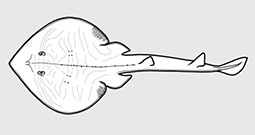
Trygonorrhinidae - (Banjo rays, Fiddler rays)
Distribution: bottom dwellers, rest on soft and hard substrates, seagrasses. Climate zone: temperate and tropical seas Habitat: all marine; primarily inshore on continental shelves to ca. 220 m depth Description: Small to large guitarfishes (with adults reaching 1.5 m TL) with a broad suboval (Trygonorrhina, Zapteryx) or wedge-shaped disc (Aptychotrema) and depressed trunk that is relatively narrow: snout very long and pointed or relatively short and broadly rounded; eyes and spiracles are small to medium-sized; spiracle with one well developed fold (Trygonorrhina) or single fold weak or absent (Aptychotrema, Zapteryx); nostrils is short and almost horizontal (rather than oblique); anterior nasal flaps are variably developed, long based, bilobed and inserted into internasal space beside innermost corner of posterior aperture or forming a nasal curtain (Trygonorrhina); mouth almost straight to strongly arched; skin with fine to very coarse denticles, with medium-sized to very large thorns in row along midline of body, usually with smaller patches near eyes and on shoulders; tail not especially robust, depressed, with well-developed lateral skin folds extending along its ventrolateral margin; folds are almost united on caudal-fin base immediately posterior to origin of ventral lobe of caudal fin; pelvic fins are short- to long-based, positioned laterally behind disc; dorsal fins 2 and well separated, first well to slightly behind rear tips of pelvic fins; small caudal fin , lacking an extended ventral lobe. Coloration often strong, with lines, bars, spots and blotches on dorsal surface; edges of cranium and rostral cartilage not sharply demarcated with snout; the ventral surface mainly white, black blotches are sometimes present on snout and posterior disc (Ref. 108568). Reproduction: Viviparous (aplacental) giving large litters of up to 18 pups. Diet: Feeds mainly on small benthic invertebrates and fishes. Fishery: not routinely caught for the fin trade, the flesh of some species are of good quality; usually caught as bycatchof trawl and set-net.
Note: Families with unknown counts of dorsal or anal spines are also included
